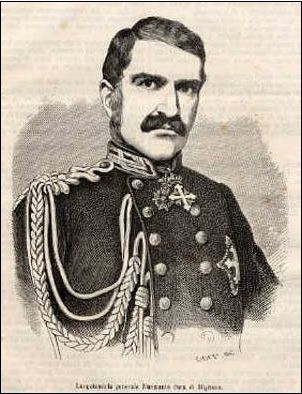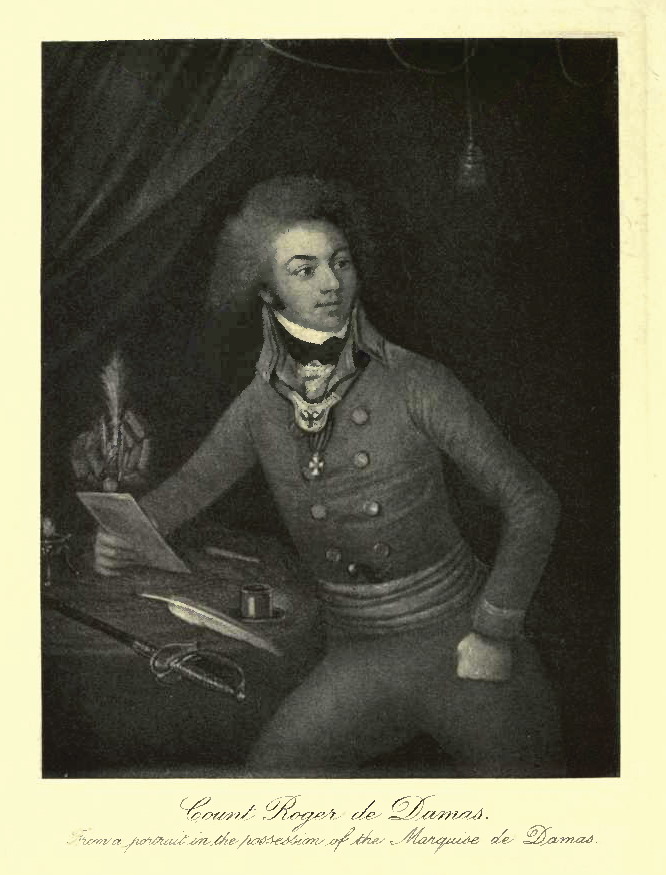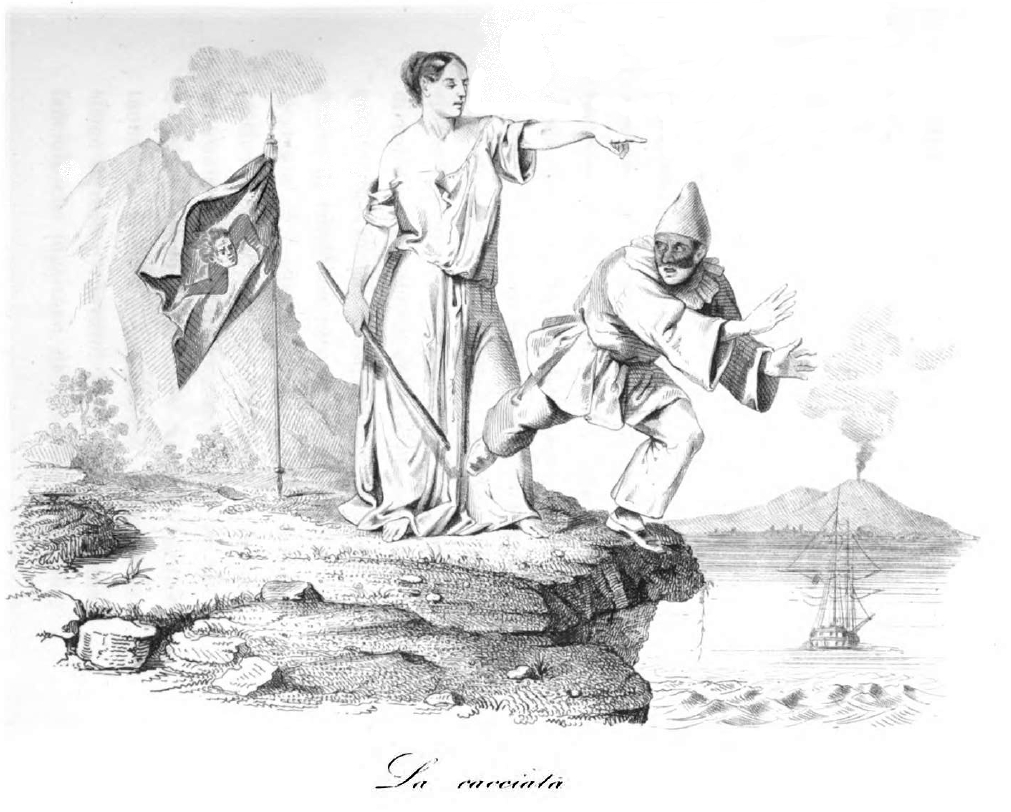|
Alessandro Nunziante
Alessandro Nunziante, Duke of Mignano (30 July 1815 – 6 March 1881), was an Italian general and politician of the Kingdom of the Two Sicilies, and, from 1861, the Kingdom of Italy. While an officer in the Bourbon Army, Nunziante was a reactionary. Although he was a friend of Ferdinand II and close collaborator with Francis II, he left the Bourbon court in 1860, resigning and returning his honors, and joined the Italian unification effort. Early life Alessandro Nunziante was born in Messina, the son of General Vito Nunziante and Camilla Barrese. In 1827, Nunziante entered the Nunziatella Military School. After completing his studies, he began his career in the 7th Regiment of the Bourbon Army. In 1839, Nunziante married Teresa Tuttavilla of the Dukes of Mignano, daughter of the Duke of Calabritto. They had 5 children: Francesco (died in infancy), Mariano, Maria Elena, Maria Camilla (died in infancy), and Pasquale (died in infancy). In 1845, Ferdinand II granted Nunzi ... [...More Info...] [...Related Items...] OR: [Wikipedia] [Google] [Baidu] [Amazon] |
Army Of The Two Sicilies
The Army of the Two Sicilies, also known as the Royal Army of His Majesty the King of the Kingdom of the Two Sicilies (''Reale Esercito di Sua Maestà il Re del Regno delle Due Sicilie''), the Bourbon Army (''Esercito Borbonico'') or the Neapolitan Army (''Esercito Napoletano''), was the land forces of the Kingdom of the Two Sicilies, whose armed forces also included Real Marina (Kingdom of the Two Sicilies), a navy. It was in existence from 1734 to 1861. It was the land armed force of the new independent state created by the settlement of the House of Bourbon-Two Sicilies, Bourbon dynasty in southern Italy following the events of the War of the Polish Succession. History Although the Royal Army arose only in 1734, the Kingdom of Naples, Neapolitan and Kingdom of Sicily, Sicilian military institutions boast a much older history, which lays its foundations in the organization of a "state" army (i.e. state and no longer feudal) by Ferdinand I of Naples in 1464. In particular, dur ... [...More Info...] [...Related Items...] OR: [Wikipedia] [Google] [Baidu] [Amazon] |
Nunziatella Military School
The Nunziatella Military School of Naples, Italy, founded November 18, 1787 under the name of ''Royal Military Academy'' (it.: ), is the oldest Italian institution of military education among those still operating after the Military Academy of Modena. Its building, familiarly called "Red Manor" (it.: ''Rosso Maniero''), and the adjacent church of the Santissima Annunziata, is an architectural monument of the city of Naples. Located in Pizzofalcone in via Generale Parisi, 16, it was a place of high military and civilian training since its foundation, and had among its teachers and students the likes of Francesco de Sanctis, Mariano d'Ayala, Carlo Pisacane, Guglielmo Pepe, Enrico Cosenz and even a king of Italy, Vittorio Emanuele III, and a Viceroy of Italian East Africa, Prince Amedeo, Duke of Aosta. Among the many alumni of prestige, high degrees of the Armed Forces, including one Director of the European Union Military Committee, two Chiefs of Defence Staff, five Army Chiefs o ... [...More Info...] [...Related Items...] OR: [Wikipedia] [Google] [Baidu] [Amazon] |
Carlo Filangieri
Carlo Filangieri (10 May 1784 – 9 October 1867), Prince of Satriano, was a Neapolitan soldier and statesman. He was the son of Gaetano Filangieri, 5th Prince of Satriano, a celebrated philosopher and jurist, and father of Gaetano Filangieri, 7th Prince of Satriano, an art historian and collector. Early life Filangieri was born on 10 May 1784 at Cava de' Tirreni, near Salerno. He was the eldest child of Gaetano Filangieri, 5th Prince of Satriano, a celebrated philosopher and jurist. His mother was the Hungarian noblewoman Carolina Frendel, who was the teacher of Princess Luisa Maria, second daughter of King Ferdinand IV. At the age of fifteen Filangieri decided on a military career, and having obtained an introduction to Napoleon Bonaparte, then first consul, was admitted to the Military Academy at Paris. Career In 1803, he received a commission in an infantry regiment, and took part in the campaign of 1805 under General Davout, first in the Low Countries, and late ... [...More Info...] [...Related Items...] OR: [Wikipedia] [Google] [Baidu] [Amazon] |
Sicilian Revolution Of 1848
The Sicilian revolution of independence of 1848 (; ) which commenced on 12 January 1848 was the first of the numerous Revolutions of 1848 which swept across Europe. It was a popular rebellion against the rule of Ferdinand II of the House of Bourbon, King of the Two Sicilies. Three revolutions against the Bourbon ruled Kingdom of the Two Sicilies had previously occurred on the island of Sicily starting from 1800: this final one resulted in an independent state (the self-proclaimed Kingdom of Sicily) which survived for 16 months. The Sicilian Constitution of 1848 which survived the 16 months was advanced for its time in liberal democratic terms, as was the proposal of a unified Italian confederation of states. It was in effect a curtain-raiser to the end of the Bourbon kingdom of the Two Sicilies, finally completed by Giuseppe Garibaldi's Expedition of the Thousand in 1860, the Siege of Gaeta of 1860–1861 and the proclamation of the unified Kingdom of Italy. The revolution Ba ... [...More Info...] [...Related Items...] OR: [Wikipedia] [Google] [Baidu] [Amazon] |
Order Of Saint George Of The Reunion
The Order of Saint George of the Reunion is an order of knighthood of the Kingdom of the Two Sicilies. It was established to replace the Royal Order of the Two-Sicilies. It was created on 1 January 1819 by Ferdinand I of the Two Sicilies to reward military valor and merit. It received its name to celebrate the reunification of Naples and Sicily into one kingdom after the Congress of Vienna. The dynastic dispute within the House of Bourbon-Two Sicilies means the position of Grand Master is disputed between Prince Pedro, Duke of Calabria and Prince Carlo, Duke of Castro. The head of the Spanish branch, Prince Pedro, considers this Order to be dormant and it is no longer awarded. Grades During the time of the Kingdom of the Two Sicilies, the Order was divided into the following grades: *''Grand Collar'' (abolished 28 September 1829), with St George and the Dragon suspended from a collar, plus a star on the left breast; *''Grand Cross'', with St George and the Dragon suspended ... [...More Info...] [...Related Items...] OR: [Wikipedia] [Google] [Baidu] [Amazon] |
Palazzo Orsini Di Gravina
The Palazzo Orsini di Gravina is a Renaissance-style palace on number 3 Via Monteoliveto, in the San Lorenzo quarter of Rione San Giuseppe-Carità, of central Naples, Italy. Since 1940, it has housed the Faculty of Architecture of the University of Naples. It is located across the street and a few doors north of the sleek and modern Palazzo delle Poste (Post Office). Across the street at the north end of the palace, is the Piazza Monteoliveto with its Fountain and the church of Sant'Anna dei Lombardi. History The palace was commissioned by the nobleman Ferdinando Orsini, who acquired lands from the nearby Santa Chiara. The first two stories of the façade were built from 1513 to 1549. The palace has changed hands many times over the centuries, and with some interludes, was linked with the prominent Orsini family till the 19th century. One of the members of the family became Pope Benedict XIII Pope Benedict XIII (; ; 2 February 1649 – 21 February 1730), born Pietro Francesco ... [...More Info...] [...Related Items...] OR: [Wikipedia] [Google] [Baidu] [Amazon] |
Revolutions Of 1848 In The Italian States
The 1848 Revolutions in the Italian states, part of the wider Revolutions of 1848 in Europe, were organized revolts in the states of the Italian peninsula and Sicily, led by intellectuals and agitators who desired a liberal government. As Italian nationalists they sought to eliminate reactionary Austrian Empire, Austrian control. During this time, Italy was not a unified country, and was List of historical states of Italy, divided into many states, which, in Northern Italy, were ruled directly or indirectly by the Austrian Empire. A desire to be independent from foreign rule, and the conservative leadership of the Austrians, led Italian revolutionaries to stage revolution in order to drive out the Austrians. The revolution was led by the state of the Kingdom of Sardinia (1720–1861), Kingdom of Sardinia. Some uprisings in the Kingdom of Lombardy–Venetia, particularly in Milan, forced the Austrian General Joseph Radetzky von Radetz, Radetzky to retreat to the Quadrilatero, Quadr ... [...More Info...] [...Related Items...] OR: [Wikipedia] [Google] [Baidu] [Amazon] |
House Of Bourbon-Two Sicilies
The House of Bourbon-Two Sicilies is a cadet branch of the House of Bourbon that ruled Southern Italy and Sicily for more than a century in the 18th and 19th centuries. It descends from the Capetian dynasty in legitimate male line through Philip V of Spain, Philip, Duke of Anjou (later Philip V of Spain), a younger grandson of Louis XIV of France (1638–1715) who established the House of Bourbon, Bourbon dynasty in Spain in 1700 as Philip V (1683–1746). In 1759, King Philip's younger grandson was appanaged with the kingdoms of Kingdom of Naples, Naples and Kingdom of Sicily, Sicily, becoming Ferdinand I of the Two Sicilies, Ferdinand IV and III (1751–1825), respectively, of those realms. His descendants occupied the joint throne, merged as the "Kingdom of the Two Sicilies" in 1816, until 1861, claimed it thereafter from exile, and constitute the extant Bourbon-Two Sicilies family. The succession of the House of Bourbon-Two Sicilies has, since 1960, been disputed between the ... [...More Info...] [...Related Items...] OR: [Wikipedia] [Google] [Baidu] [Amazon] |
Major (rank)
Major is a senior military Officer (armed forces), officer military rank, rank used in many countries. When used unhyphenated and in conjunction with no other indicators, major is one rank above Captain (land), captain in armies and air forces, and one rank below lieutenant colonel. It is considered the most junior of the senior officer ranks. Background Etymologically, the word stems from the Latin word meaning "greater". The rank can be traced back to the rank of sergeant major general, which was shortened to sergeant major, and subsequently shortened to ''major''. When used in hyphenated or combined fashion, the term can also imply seniority at other levels of rank, including major general, denoting a low-level general officer, and sergeant major, denoting the most senior non-commissioned officer (NCO) of a military unit. The term major can also be used with a hyphen to denote the leader of a military band such as in Pipe-Major, pipe-major or drum-major. Links to major ... [...More Info...] [...Related Items...] OR: [Wikipedia] [Google] [Baidu] [Amazon] |






